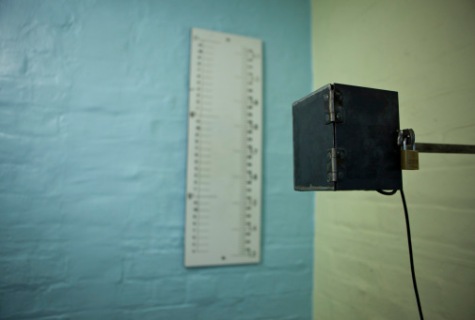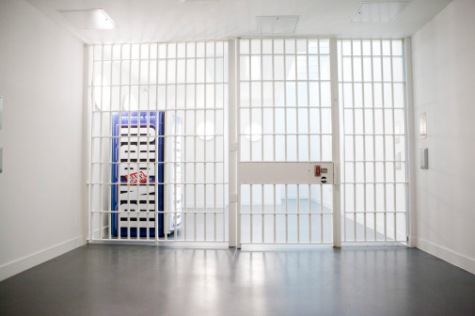
Body orifice scanner and surveillance camera, HMP Low Moss, 2012
UK photographer and artist, Jenny Wicks – working as an artist in residence at The Scottish Centre for Crime and Justice Research (SCCJR) at Glasgow University, the largest centre for criminological research in Scotland – set out a year ago to document spaces of said research. Invariably this meant photographing prisons. She photographed in two working prisons – Her Majesty’s Prison (HMP) Barlinnie and HMP Shotts. She also shot in a new prison, HMP Low Moss, prior to its opening.
I have posted before about Wick’s portrait project They Are Us And We Are Them also completed during the residency. Here, I’d like to focus on Wick’s prison interior photographs.
Wicks’ research broadly titled Working Spaces, Punishing Spaces: The Meaning and Construction of Place through Criminological Research sought to explore key boundaries: between innocent and guilty, researcher and researched.
“The conceptual frame for the project focuses on the ways criminological researchers relate to the spaces where research is conducted, analysed and disseminated,” writes Wicks. “A central premise is that working in particular spaces simultaneously contributes to their meaning as places of punishment.”
Wicks’ aim was to expose hidden sites. To differing degrees, this is a common aim of photography in prisons, so it is therefore paramount to say that Wicks delivers plenty of interesting images, the likes of which I, and we, have probably not seen before.
Keep reading below.

Scanner and cones on cell wing, HMP Barlinnie, 2012
Orifice scanner and zimmer frame, HMP Barlinnie, 2012
Gym, HMP Shotts, 2012.
Personal belongings tags, HMP Barlinnie, 2012
My dad used to use the same Carte d’Or ice-cream tubs (see above image) to store screws and brackets in the garage when I was young. It’s a jolt to see such a practical, modest storage solution crop up within a prison.
But then again, prisons are full of the mundane. Images of the ordinary (latex gloves, powdered milk, hygiene products, boring carpet) are balanced with constant, also pedantic details reminding us of the disciplining function of prisons (overly instructive signs, fire safety posters about escape, painted walkway instructions, holding cells, scanners).
Sometimes the juxtapositions seem too ironic, but then in turn sad. The awards that hang over the chairs in the medical office are shinier than the untarnished plaque of ‘quit smoking’ and ‘mouth cancer’ posters. There’s a flimsy lock on the back of the mugshot camera box. Stored neatly in a stairwell are an orifice scanner and zimmer frame side-by-side. This reminds me of Edmund Clark’s evidentiary images of clearly infirm prisoners in Portsmouth, England.
In Wicks’ book (see below), photographs of segregation cells for prisoners follow those of dog kennel cages.
In the HMP Low Moss new library, we see promise. An image of the books stored prior to shelving tells us prisoners read the same horror-schlock (Stephen King) as the everyman reads. Oh, and there’s a vacuum cleaner to maintain that boring carpet.
Also in the shiny new HMP Moss is a row of green-tint-windowed visiting rooms. They look like the sterile, institution environments of cinema – I’m thinking of the psychiatric wing of Michael Mann’s early eighties film Manhunter, in which Brian Cox stars as Hannibal Lector, not Anthony Hopkins.
The electrics still going in and Wicks captures the work of contractors at mid-point. The literal description of construction reminds us of the ties between labour and prisons. These are spaces paid for and made by society to meet a socially-agreed end. Hopefully resources and money invested in a new prison brings about better opportunities for rehab and a positive economic return further down the line through the reduction of crime and its associated social costs.
The prisoners must do work too. Wicks photographed recreation schedules as well as work rosters. We learn from an HMP Low Moss electronic notice board that “the finer details of prisoner mobilization plan are progressing,” a burauecratic way of saying they’ll be moving in soon. Alternatively, if we take note of text in the older prisons, we’ll be reading graffiti. Such-and-suchabody was here. We know that soon enough, prisoners will be there, in their new quarters. Does it matter if the burned graffiti reads “Jobby bum” or “jobby burn”? Does it instruct us more or does it just convince us that prisons are heavily used and heavily contested spaces? If anything, I hope Wicks’ coverage of Scottish prisons old and new demonstrate that – if we must incarcerate people – we do so in sanitary, safe places with wide provision of work, vocational and educational training.
If prisons fulfil those key criteria then prisons should theoretically be able to open gates to photographers. Imagine a day when human improvement and human rights could become the key content of prison imagery?
Keep reading below.
IMAGES: HMP BARLINNIE
HMP Barlinnie, 2012
Detention dog kennels, HMP Barlinnie, 2012
Photography apparatus, HMP Barlinnie, 2012
Toilets, HMP Barlinnie, 2012
Sinks, HMP Barlinnie, 2012
Personal belongings in a cell, HMP Barlinnie, 2012
Personal belongings in a cell, HMP Barlinnie, 2012
Wicks believes (and I concur) that depictions of crime, and crime science, in popular culture represent that world through a narrow and increasingly hackneyed set of spaces – the crime lab and courtroom offering two examples.
“As the residency progressed I discovered striking juxtapositions of the mundane and the spectacular in the work of criminology,” says Wicks. “Suicide watch cells, the back of a prisoner transport van, a storage room holding physical restraint chairs and Zimmer frames mark sites of extreme human experience and yet at the same time are part of someone’s day at the office: a site where data is collected, transferred to spreadsheets and displayed to audiences in lecture theatres and conference halls. Exploring this dynamic tension is a key aim of the project.”
Keep reading below.
IMAGES: HMP LOW MOSS
HMP Low Moss, 2012
Bars and Irn Bru machine, HMP Low Moss, 2012
HMP Low Moss, 2012
New library, HMP Low Moss, 2012
HMP Low Moss, 2012
THE BOOK, CORRECT
Wicks was kind enough to send me a copy of Correct. It’s a compact book of 86 pages. You can view a 25-page preview and buy the book through Blurb. My copy came with a fold out of 60 portrait thumbnails of portraits from They Are Us And We Are Them. I include some images below.





Segregation unit exercise yard, HMP Shotts, 2012.
THE EXHIBITION, CORRECT: THE MEANING AND CONSTRUCTION OF SPACE
The exhibition titled ‘CORRECT’: The Meaning and Construction of Place features two audio pieces, and an installation The Gallows, an installation of large format film giclée prints from They Are Us And We Are Them. You can see here a video of The Gallows previously exhibited in HMP Barlinnie.
The exhibition also features The Desk, a digital collage of giclée prints of criminologist’s desks.
“Closely cropped, excluding the life beyond the frame. Voyeuristic and subtly relating to the prison visiting experience: they are intrusive, this is a space where someone lives most of their waking week, a place the research comes back to and is pieced together. A personal space that appears impersonal. Cluttered with cheap plastic Chinese electronics, stationary, diary’s (hand made), mouse pads of choice, daily calendars, hand cream, distinctive handwriting and lots of notes,” writes Wicks.
Finally, and central, the exhibition includes digital C-type prints of prison interiors.
“They are an exploration of crime and justice spaces that criminologists inhabit. Such sites are more usually associated with highly iconic images of justice (bars, ankle tags, gavels) that are part of a larger popular essentialism of crime and punishment, i.e. places of cultural cliché,” writes Wicks. “I aim to demystify these places and the work criminologists undertake. Some of the images juxtapose the often-chaotic lives that occupy these spaces and contradict the harsh realities of prison life.”
‘CORRECT’: The Meaning and Construction of Place is on show now at The Briggait, 141 Bridgegate, Glasgow G1 5HZ from March 3rd – 22nd. Monday- Friday, 9.00 am to 5.00 pm.


















4 comments
Comments feed for this article
March 6, 2013 at 8:47 am
Catana
This new prison may be an improvement on many old ones, but it’s still a sterile cage for people that society has decided need to be shut away.
April 25, 2013 at 5:06 pm
Fotografía de prisioneros y cárceles
[…] derechos humanos. Hay fotos interesantes como unas fotos aéreas de varias cárceles, detalles de prisiones escocesas, retratos de prisioneros indígenas en Ciudad Juárez, etc. Si eres un fotógrafo que ha trabajado […]
October 15, 2013 at 2:38 pm
research on project 2 | alannahcturnerphotography
[…] research on project 2 […]
December 30, 2014 at 9:04 am
Troubling Institutions – exploring spaces of security and care | Asylum and Post-Asylum Spaces
[…] We were really happy to be able to welcome so many people to join us from such diverse backgrounds. ‘Troubling institutions’ could only scratch the surface of different spaces of security and care but we think it made clear how important research into these environments is. The interest in the conference also showed that it is still very much a timely matter and touches many different practices and theories. There is scope for further conceptual debates as well as more practice based involvement. This has been a special opportunity for us to be able to link different disciplines and sub-disciplines and have such a lively and interesting discussion. It was great to be able to join up different initiatives and networks like SCCJR, carceral geography and our own asylum and post-asylum network. Particular thanks go to the SCCJR for providing a small exhibition by their artist in residence Jenny Wickes on institutional spaces of punishment. […]